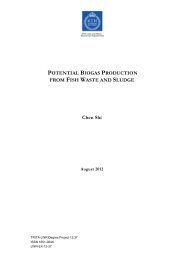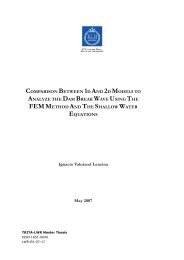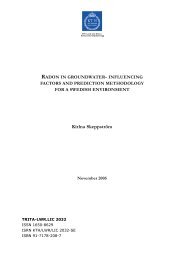Water <strong>sources</strong>, <strong>infrastructure</strong>, <strong>space</strong> <strong>and</strong> <strong>the</strong> <strong>dynamics</strong> <strong>of</strong> environmental diseases in Saboba District: Using GISImplementers: Saboba District Assembly, <strong>the</strong> District Health InsuranceScheme, Chiefs <strong>and</strong> opinion leaders, Utindan (l<strong>and</strong>-chiefs), Umoadanbor(river-chiefs), ministries <strong>of</strong> Health, Water Re<strong>sources</strong>, Works <strong>and</strong>Housing, Education <strong>and</strong> Science, <strong>and</strong> Information <strong>and</strong> NationalOrientation, judicial service (adjudication) <strong>and</strong> police service (lawenforcement).Financiers: Government <strong>of</strong> Ghana, Saboba District Assembly (CommonFund), ministries <strong>of</strong> Water Re<strong>sources</strong>, Works <strong>and</strong> Housing, Education<strong>and</strong> Science, Health, <strong>and</strong> Local Government <strong>and</strong> Rural Development,Ghana Water Commission, Ghana <strong>water</strong> company Ltd (GWCL), donors(DANIDA, USAID <strong>and</strong> CIDA), individuals/companies <strong>and</strong> SabobaMember <strong>of</strong> Parliament (MP Common Fund).Methods <strong>and</strong> materialsThis section explains how <strong>the</strong> data used in this study was acquired <strong>and</strong>analysed.Data SourcesPrimary <strong>and</strong> secondary <strong>sources</strong> <strong>of</strong> data were used in this research (Fig. 3).The <strong>sources</strong> <strong>of</strong> secondary data included Saboba Medical Centre (SMC)<strong>and</strong> Wapuli Health Centre (WHC) patient-records, annual report <strong>of</strong> <strong>the</strong>District Health <strong>and</strong> Management Team (DHMT), <strong>the</strong> Saboba DistrictHealth Insurance records <strong>and</strong> Ghana Statistical Service (GSS). The<strong>sources</strong> <strong>of</strong> primary data included questionnaire, structured <strong>and</strong>unstructured interviews, <strong>and</strong> personal observations <strong>and</strong> analysis. Myexperiences gained while working with Integrated Development Centre(IDC) – a local NGO formally in-charged <strong>of</strong> <strong>the</strong> implementation <strong>of</strong> <strong>the</strong>district’s Health Insurance Scheme <strong>and</strong> creating awareness programmeson behalf <strong>of</strong> Community Water <strong>and</strong> Sanitation Agency (CWSA) <strong>and</strong>Danish International Development Agency (DANIDA) is also used. The<strong>sources</strong> <strong>of</strong> GIS data are Centre for Remote Sensing <strong>and</strong> GeographicInformation Service (CERGIS) <strong>of</strong> University <strong>of</strong> Ghana <strong>and</strong> Allotey et al(1999).SamplingFor <strong>the</strong> collection <strong>of</strong> primary data, questionnaires were administeredusing r<strong>and</strong>om sampling to respondents aged 15 years <strong>and</strong> above,between August <strong>and</strong> October <strong>of</strong> 2007. The questionnaires wereadministered to 130 respondents in five selected areas: CentralTownship, Toma <strong>and</strong> Chief-section, which form <strong>the</strong> Saboba town(bigger town) <strong>and</strong> its environs, Wapuli (a small town) <strong>and</strong> Bordagbalm (avillage). Also, 5020, 4080 <strong>and</strong> 4000 records <strong>of</strong> individuals (that included<strong>the</strong> type <strong>of</strong> disease one was treated on, <strong>the</strong> place <strong>the</strong> person resides <strong>and</strong><strong>the</strong> cost <strong>of</strong> treatment) were sampled from Saboba Medical Centre (SMC),Wapuli Health Centre (WHC) <strong>and</strong> <strong>the</strong> National Health Insurance Office,Saboba, respectively. Since such detail information (place, cost etc) aremissing after data collation, I had to sample rough <strong>and</strong> h<strong>and</strong>-writtenrecorded <strong>sources</strong>. Similar data from o<strong>the</strong>r areas with clinics <strong>and</strong> healthposts (<strong>of</strong> which flooded roads prevented me from accessing) wasretrieved from <strong>the</strong> District Health Management Team (DHMT) annualreport, which reports on <strong>the</strong> health statistics <strong>of</strong> <strong>the</strong> district. All <strong>the</strong>se<strong>sources</strong> contained almost similar data <strong>and</strong> were only taken to comparewhe<strong>the</strong>r <strong>the</strong>y all follow <strong>the</strong> same trend before any conclusion could bedrawn. In Wapuli, <strong>the</strong> trend was a bit undefined, hence a previous year(2006) records <strong>of</strong> 6,484 was used to see <strong>the</strong> trend <strong>of</strong> event. I will urgeanyone who wants to undertake similar research; especially involvingspatial analysis <strong>of</strong> health, in <strong>the</strong> district to rely on <strong>the</strong> first h<strong>and</strong>-written13
Mat<strong>the</strong>w Biniyam KursahTRITA LWR Master Thesisrecords from <strong>the</strong> hospital, clinics <strong>and</strong> health posts. This is because, <strong>and</strong>sadly <strong>of</strong> course, <strong>the</strong> more <strong>the</strong> data goes up <strong>the</strong> health administrativeladder, <strong>the</strong> more <strong>space</strong> become unimportant variables <strong>and</strong> omitted from<strong>the</strong> data. I will like to caution readers that when it comes to <strong>the</strong> spatialanalysis in chapter 3, <strong>the</strong> totals may not add-up to <strong>the</strong> sampled size sincesome villages are not on <strong>the</strong> map, hence <strong>the</strong>ir respective healthincidences are not shown as well.Statistical analysisTrends, changes, relationships <strong>and</strong> variations <strong>of</strong> variables from <strong>the</strong> datacollected were done using Statistical Package for Social Sciences (SPSS).SPSS was used to present <strong>the</strong> various views from <strong>the</strong> questionnairesadministered to respondents. Simple statistical methods such as tables<strong>and</strong> graphs are used to show distribution <strong>and</strong> trends, while percentages<strong>and</strong> ratios are used to depict rates <strong>of</strong> health indices.Spatial AnalysisGeographic Information System (GIS – ArcGIS) was used to identifyspatial dimensions <strong>of</strong> <strong>water</strong> related diseases in <strong>the</strong> district. The incidences<strong>of</strong> <strong>the</strong> three leading diseases (Malaria, Typhoid <strong>and</strong> RTI) in <strong>the</strong> district<strong>and</strong> distances to major towns, roads <strong>and</strong> <strong>water</strong>courses, <strong>and</strong> <strong>the</strong> type <strong>of</strong>l<strong>and</strong> cover <strong>and</strong> elevation were extracted using ArcGIS tool: Spatial Analyst– Distance – Straight line. The results was extracted into DBF 4 – MSExcel <strong>and</strong> <strong>the</strong>n to SPSS where <strong>the</strong> significance was tested usingcorrelation. For <strong>the</strong> purpose <strong>of</strong> this study, 0.05 level is consideredsignificant, <strong>and</strong> any variables with a correlation higher than 0.05 isconsidered insignificant. The dependent variables includedenvironmental diseases, geographically defined, while <strong>the</strong> independentvariables are <strong>the</strong> distances to <strong>the</strong> urban area (<strong>the</strong> main town in <strong>the</strong>district), <strong>water</strong>courses, roads, <strong>the</strong> type <strong>of</strong> l<strong>and</strong> cover <strong>and</strong> elevation.Figure 3: Data collection process14
- Page 1 and 2: Supervisor: Ulla MortbergCo-supervi
- Page 3 and 4: Water sources, infrastructure, spac
- Page 5 and 6: Water sources, infrastructure, spac
- Page 7 and 8: Water sources, infrastructure, spac
- Page 9 and 10: Water sources, infrastructure, spac
- Page 11 and 12: Water sources, infrastructure, spac
- Page 13 and 14: Water sources, infrastructure, spac
- Page 15 and 16: Water sources, infrastructure, spac
- Page 17 and 18: Matthew Biniyam KursahTRITA LWR Mas
- Page 19 and 20: Matthew Biniyam KursahTRITA LWR Mas
- Page 21 and 22: Matthew Biniyam KursahTRITA LWR Mas
- Page 23 and 24: Matthew Biniyam KursahTRITA LWR Mas
- Page 25 and 26: OberadeYusungaManieBilyimbaMatthew
- Page 27: Matthew Biniyam KursahTRITA LWR Mas
- Page 31 and 32: Matthew Biniyam KursahTRITA LWR Mas
- Page 33 and 34: Matthew Biniyam KursahTRITA LWR Mas
- Page 35 and 36: Matthew Biniyam KursahTRITA LWR Mas
- Page 37 and 38: Matthew Biniyam KursahTRITA LWR Mas
- Page 39 and 40: Matthew Biniyam KursahTRITA LWR Mas
- Page 41 and 42: PercentagePercentageMatthew Biniyam
- Page 43 and 44: Matthew Biniyam KursahTRITA LWR Mas
- Page 45 and 46: Matthew Biniyam KursahTRITA LWR Mas
- Page 47 and 48: Matthew Biniyam KursahTRITA LWR Mas
- Page 49 and 50: BilyimbaMatthew Biniyam Kursah Nadu
- Page 51 and 52: ManieBilyimbaBaguliMatthew Biniyam
- Page 53: ManieBilyimbaMatthew Biniyam Kursah
- Page 56 and 57: Matthew Biniyam KursahTRITA LWR Mas
- Page 58 and 59: Matthew Biniyam KursahTRITA LWR Mas
- Page 60 and 61: Matthew Biniyam KursahTRITA LWR Mas
- Page 62 and 63: Matthew Biniyam KursahTRITA LWR Mas
- Page 64 and 65: Matthew Biniyam KursahTRITA LWR Mas
- Page 66 and 67: PercentagesPercentagesMatthew Biniy
- Page 68 and 69: PercentagesMatthew Biniyam KursahTR
- Page 70 and 71: Matthew Biniyam KursahTRITA LWR Mas
- Page 72 and 73: Matthew Biniyam KursahTRITA LWR Mas
- Page 74 and 75: Matthew Biniyam KursahTRITA LWR Mas
- Page 76 and 77: Matthew Biniyam KursahTRITA LWR Mas
- Page 78 and 79:
Matthew Biniyam KursahTRITA LWR Mas
- Page 80 and 81:
Matthew Biniyam KursahTRITA LWR Mas
- Page 82 and 83:
Matthew Biniyam KursahTRITA LWR Mas
- Page 84 and 85:
Matthew Biniyam KursahTRITA LWR Mas
- Page 86 and 87:
Matthew Biniyam KursahTRITA LWR Mas
- Page 88 and 89:
Matthew Biniyam KursahTRITA LWR Mas
















